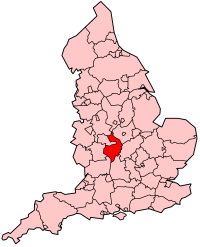| Warwickshire | |
|---|---|

| |
| Geography | |
| Status: | Ceremonial & Administrative County |
| Region: | West Midlands |
| Area: - Total - Admin. council |
Ranked 31st 1,975 km² Ranked 28th |
| Admin HQ: | Warwick |
| ISO 3166-2: | GB-WAR |
| ONS code: | 44 |
| NUTS 3: | UKG13 |
| Demographics | |
| Population: - Total (2002 est.) - Density - Admin. council |
Ranked 39th 512,680 260 / km² Ranked 23rd |
| Ethnicity: | 95.6% White 2.8% S.Asian |
| Politics | |
| Warwickshire County Council http://www.warwickshire.gov.uk/ | |
| Executive: | Labour |
| MPs: | Andy King, John Maples, Mike O'Brien, Bill Olner, James Plaskitt |
| Districts | |
 | |
Warwickshire (pronounced worrickshur) is a landlocked county in central England. Modern-day Warwickshire is of a considerably different shape to the historic county. The county town is Warwick.
Famous people from Warwickshire include: William Shakespeare, from Stratford-upon-Avon, George Eliot from near Nuneaton, Rupert Brooke from Rugby, and Frank Whittle from Coventry (then a part of Warwickshire). J. R. R. Tolkien though not born in Warwickshire lived as a child in the village of Sarehole before moving to Birmingham.
Geography
For local government purposes, Warwickshire is divided into a number of district councils. These are North Warwickshire, Nuneaton and Bedworth, Rugby, Stratford, and Warwick.
The historic county of Warwickshire included Coventry, Solihull, and most of Birmingham. These became part of the West Midlands county following local government re-organisation in 1974. However Warwickshire County Cricket Club is still based at Edgbaston in Birmingham, observing the traditional county boundaries. The town of Tamworth was historically divided between Warwickshire and Staffordshire, but is now fully in Staffordshire
Coventry and Warwickshire are often treated as a single area for some administrative purposes such as NHS administration.
Warwickshire is bounded to the northwest by the West Midlands county (formed in the local government reorganisation of 1974) and Staffordshire, by Leicestershire to the northeast, Northamptonshire to the east, Oxfordshire to the south, Gloucestershire to the southwest, and Worcestershire to the west.
The largest towns in Warwickshire as of 2004 are: Nuneaton ( pop. 77,500), Rugby (62,100), Leamington Spa (42,300), and Bedworth (pop 32,500).
The bulk of Warwickshire's population lives in the north and centre of the county, The north has traditionally been industrial, with towns such as Nuneaton, Bedworth and Rugby whose traditional industries include (or included) coal mining, textiles, cement production, and engineering.
In the centre and west of Warwickshire lie the prosperous towns of Leamington Spa, Warwick, Kenilworth, and Stratford-upon-Avon.
The south of the county is largely rural and sparsely populated, and includes no towns of any significant size. The southern fringe of Warwickshire includes a small area of the Cotswolds.
Historically much of western Warwickshire, including the area now forming part of Birmingham and the West Midlands, was covered by the ancient Forest of Arden (although most of this was cut down to provide fuel for industrialisation in the 17th to 19th centuries). For this reason, several places in the northwestern part of Warwickshire have names with the termination "-in-Arden".
History
Main article: History of Warwickshire.
Warwickshire came into being as a division of the kingdom of Mercia in the early 11th century, the first reference to Warwickshire was in 1001, named for Warwick (meaning "dwellings by the weir").
Warwickshire played a key part in the English Civil War, with the Battle of Edgehill and other skirmishes taking place in the county.
During the Industrial Revolution Warwickshire became one of Britain's foremost industrial counties, with the large industrial city's of Birmingham and Coventry within its boundaries.
1974 boundary changes removed Birmingham and Coventry from Warwickshire, leaving the present day county with a rather odd shape, which looks like a large chunk has been bitten out of it.
Towns
Selected Villages
For a fuller list see Villages in Warwickshire
Places of interest
- Arbury Hall
- Compton Wynyates
- Coombe Abbey
- Coventry Canal
- Draycote Water
- Grand Union Canal
- Ladywalk Reserve
- Lunt Fort
- Kenilworth Castle
- Kingsbury Water Park
- Mary Arden's House
- Oxford Canal
- River Avon
- Rollright Stones
- Rugby School
- Warwick Castle
See also